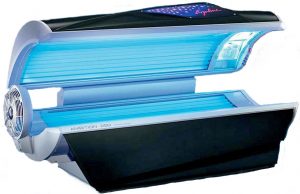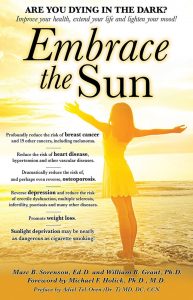Vitamin D levels: sufficient for winter? By Marc Sorenson, EdD
 Vitamin D levels and sunshine are exceptionally important to human health, and therefore we should be aware of vitamin D science. The Vitamin D Society of Canada is always at the forefront of the research on vitamin D levels and sunlight. And, they deliver press releases to keep people from Canada (and the world) apprised of new and important findings. Hence, I would like to comment on the salient points of their latest release. As I do so, it is especially relevant to note that vitamin D levels are surrogate measures for sun exposure.
Vitamin D levels and sunshine are exceptionally important to human health, and therefore we should be aware of vitamin D science. The Vitamin D Society of Canada is always at the forefront of the research on vitamin D levels and sunlight. And, they deliver press releases to keep people from Canada (and the world) apprised of new and important findings. Hence, I would like to comment on the salient points of their latest release. As I do so, it is especially relevant to note that vitamin D levels are surrogate measures for sun exposure.
The relationship of vitamin D to sun exposure
Ninety percent of vitamin D levels in the blood is due to sun exposure.[1] The UVB portion of sunlight stimulates vitamin D production in skin. Therefore, a UVB light source, which produces vitamin D levels, is the best source in winter. Remember also that the press release information is true for the world, not just Canada.
Salient points about vitamin D levels and sunlight: breast cancer
- First of all, consider a breast-cancer study published in the scientific journal, Plos One.[2] It showed that women with the highest vitamin D levels had a reduced breast-cancer risk. Most noteworthy, women with levels > 60 ng/ml had 82% reduced risk, compared to those with levels < 20 ng/ml. Furthermore, there was a dose-response decrease. For each increase in vitamin D levels, there was a concomitant decrease is breast-cancer risk.
Vitamin D levels and Breast Cancer
- Since we mentioned that vitamin D is produced by sun exposure, we should mention an Iranian sunlight-breast cancer study. In Iran, among women who totally avoid sun exposure, there is a 10-fold increase breast cancer risk.[3] That is an especially relevant fact for women who believe they should avoid the sun! And remember, melanoma is also reduced in those who are regularly exposed to sunlight.[4]
Another Vitamin D levels- and sunlight-deficiency cancer
- It seems like if breast cancer is reduced by high vitamin D levels, the same relationship could exist for other cancers. Hence, the press release mentioned colorectal cancer as the second disease associated to low vitamin D levels or low sun exposure. And, it mentioned another important piece of research.[5] Participants with vitamin D levels below 12 ng/ml had a 31% higher risk of colorectal cancer. Those with levels above 30 ng/ml had a 27% reduced risk.
Other disorders associated with vitamin D levels
In addition, the press release mentions four other disorders where higher vitamin D levels reduce risk or improve the condition. The disorders: diabetes (81% reduced risk), multiple sclerosis (45% reduced risk), preterm birth (62% reduced risk) and poor cognitive function. As to cognitive function, those who spent the most time outdoors with the least sun protection, had better cognitive function.
Finally, this is an excellent press release regarding vitamin D levels and sunlight. I strongly suggest you read it. http://www.vitamindsociety.org/press_release.php?id=60 Also, see the previous blog regarding the vitamin D Society and vitamin D levels: http://sunlightinstitute.org/vitamin-d-canada-warning/
Vitamin D and sunlight are sine qua nons for health, and so are proper nutritional habits. Happy health! Be sure to read my book, Embrace the Sun, available at Amazon. 
[1] Reichrath J. The challenge resulting from positive and negative effects of sun: how much solar UV exposure is appropriate to balance between risks of vitamin D deficiency and skin cancer? Prog Biophys Mol Biol 2006;92(1):9-16
[2] McDonnell SL, Baggerly CA, French CB, Baggerly LL, Garland CF, Gorham ED, Hollis BW, Trump DL, Lappe JM. Breast cancer risk markedly lower with serum 25-hydroxyvitamin D concentrations ≥60 vs <20 ng/ml (150 vs 50 nmol/L): Pooled analysis of two randomized trials and a prospective cohort. PLoS One. 2018 Jun 15;13(6).
[3] Bidgoli SA, Azarshab H. Role of vitamin D deficiency and lack of sun exposure in the incidence of premenopausal breast cancer: a case control study in Sabzevar, Iran. Asian Pac J Cancer Prev. 2014;15(8):3391-6.
[4] Vågero D, Ringbäck G, Kiviranta H. Melanoma and other tumors of the skin among office, other indoor and outdoor workers in Sweden 1961–1979. Brit J Cancer 1986;53:507–12.
[5] McCullough ML, Zoltick ES, Weinstein SJ, Fedirko V, Wang M, et al. Circulating Vitamin D and Colorectal Cancer Risk: An International Pooling Project of 17 Cohorts. J Natl Cancer Inst. 2018 Jun 14.
 Vitamin D is essential in Canada (and Ely). By Marc Sorenson, EdD.
Vitamin D is essential in Canada (and Ely). By Marc Sorenson, EdD.
I just received an excellent press release from my friend Perry Holman, who is touting the Canadian Vitamin D Day. Perry is the Executive Director of the Vitamin D Society. The Society is alarmed about the lack of sunlight and vitamin D production during the long Canadian winter. The points made in the press release, however, are also relevant for all areas of the U.S. that have long, cold winters. This would include Ely, Nevada, my high-school hangout. Therefore, this blog contains a couple of editorial comments regarding Ely and other points in the U.S. [Ely, Minnesota would certainly need this advice too.]
The current lack of vitamin D is due to of the position of the sun in the winter sky. All of the UVB light that stimulates vitamin D production (and many other essential photoproducts) is filtered out when the sun drops too close to the southern horizon.
Here are a few of the salient points made in the release:
- Vitamin D levels plummet this time of year, since the sun can no longer make vitamin D. [This is also true of Ely, NV, where most vitamin D production ceases on about October 1. It starts up again about March 1.]
- 93% of Canadians are vitamin D deficient. [For Ely, the number is probably closer to 50%, but for the Northern states in the U.S., the number is probably closer to 80%.
- This deficiency leads to 23,000 premature deaths yearly in Canada. See this link: https://www.ncbi.nlm.nih.gov/pmc/articles/PMC5129897/pdf/kder-08-01-1248324.pdf
- There are two primary sources of vitamin D Canadians should consider during the winter – artificial UVB exposure and vitamin D3 supplements.
- Artificial UVB exposure can be a surrogate for summer sunshine and is obtained from most sunbeds or through special UVB lamps designed for home use.
- A recent Canadian study found that regular use of sunbeds with UVB similar to outdoor summer sun significantly raised participants’ vitamin D levels to the optimal range. See this link: https://www.ncbi.nlm.nih.gov/pmc/articles/PMC5821157/
- Perry Holman states: “The current health policy limiting sun exposure may be causing more deaths and disease than its preventing. Vitamin D levels have been dropping and more people are becoming vitamin D deficient in Canada. We need a change in direction to encourage people to get moderate non-burning sun exposure to prevent vitamin D deficiency and reduce the risk of serious diseases.” [My comment here is that the research in my book shows the following: for every single death caused by diseases associated with sun exposure, there are approximately 328 deaths caused by diseases associated with sun deprivation.]
Whether you live in Canada, Ely, Nevada, or anywhere else where you either avoid the sun or have no availability of vitamin D-producing sunlight during the colder seasons, you should read this press release. http://www.vitamindsociety.org/press_release.php?id=59
Happy sunning, and as another of my Canadian friends says, “Have a D-lightful day!” And, read my new book, Embrace the Sun, available at Amazon: https://www.amazon.com/Embrace-Sun-Marc-B-Sorenson/dp/069207600X/ref=sr_1_1?ie=UTF8&qid=1540903899&sr=8-1&keywords=embrace+the+sun+sorenson
By Marc Sorenson, EdD. Sunlight Institute…
Canada has a long season each year in which vitamin D from sunlight is not available. Due to the northern latitude of Canada, May through October is the only period when vitamin D can be produced in response to sun exposure to the skin. Therefore, a new press release from the Vitamin D Society recommends to protect health by building up vitamin D during the summer. Vitamin D from the summer sun helps to prevent serious diseases such as cancer, cardiovascular diseases, diabetes, multiple sclerosis and others.
Dr. Reinhold Vieth, the scientific advisor for the Society, states the following: We often assume that the health benefits of sunshine are solely due to vitamin D, but that is not proven yet. In other words, it is likely that sunshine does more for our bodies than just produce vitamin D.”
Dr. Vieth is correct. Vitamin D is only one of several products of sun exposure. Others are nitric oxide, which helps prevent vascular problems, and serotonin and endorphins that enhance mood. It is likely that there are many more products of sun exposure that enhance human health.
The Society recommends 6 guidelines for safely enjoying the sun and its health benefits:
- Be moderate, and don’t burn.
- Sun exposure can produce vitamin D only during the mid-day hours, so be outside between 10 AM and 4 PM.
- Know your skin type and risk of burning. Red hair and very light skin predict a greater risk of burning. (Also remember that dark skin needs more sun exposure to produce vitamin D).
- A gradual build-up of a tan protects the skin from burning.
- When the skin begins to redden, it is time to stop the sun exposure.
- Frequent but shorter sun exposure times are better for producing vitamin D.
Since about 35% of all Canadians do not meet suggested vitamin D requirements, sun exposure is essential to reverse that statistic.
So Canadians, safely enjoy the sun this summer!
To read the entire press release, go to this link: http://www.vitamindsociety.org/press_release.php?id=44

